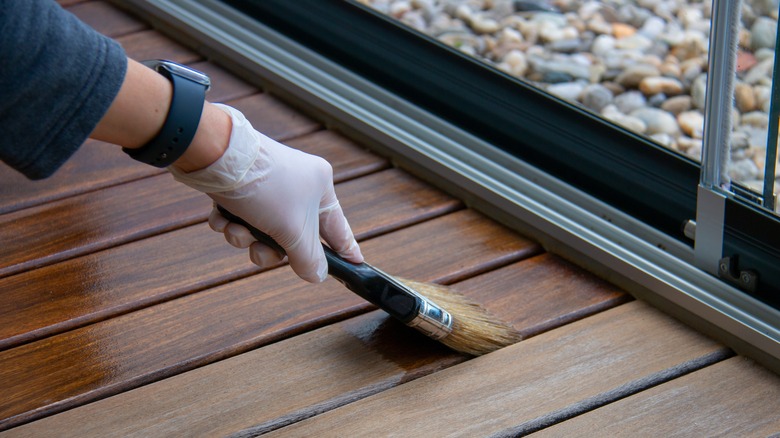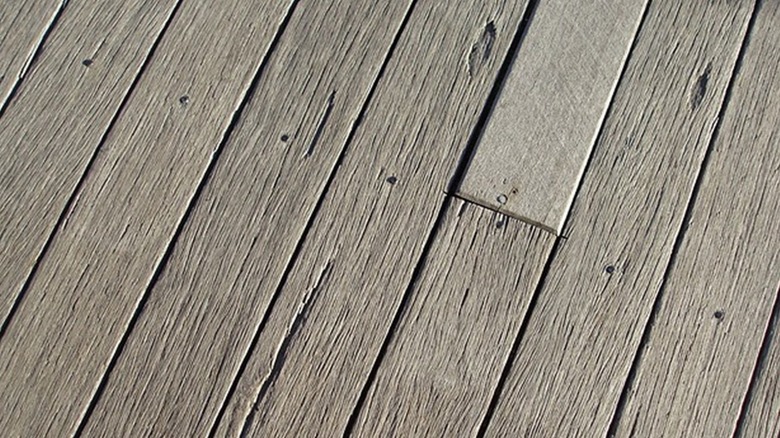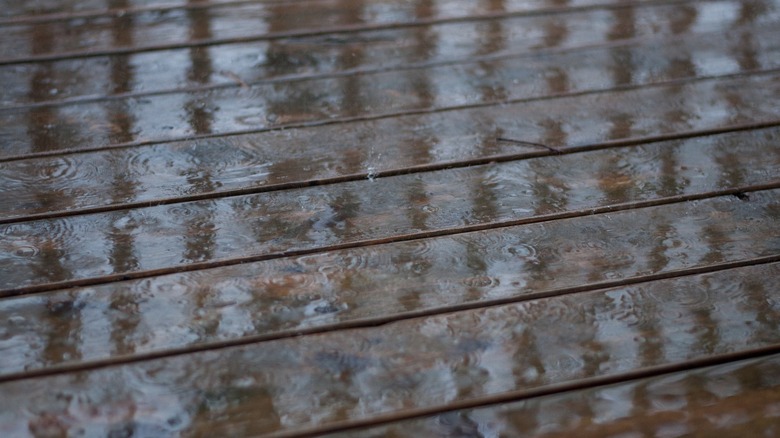Oil Vs Water: Which Is The Right Stain For Your Deck?
Whether you have a new deck, or your plan is to recoat or refurbish a long-standing deck, the question comes up about what kind of stain is best -– an oil-based stain or a water-based one. Granted, there are bigger issues when it comes to decks, like avoiding costly design mistakes. And it's not as if one stain or the other will cause irreparable damage to your deck. One product isn't better than the other. But the answer lies in the detail of what's right for your deck. After all, there are a number of variables to consider before sealing wood.
We'll get to the pros and cons of each type of stain, but before you buy anything, think about these factors. First, there's the type of wood. If the wood is oily, like cedar or redwood, it's better to use an oil-based stain. Pressed wood, like pine, does better with water-based stains. Do you live in an area with high humidity? If so, an oil-based stain has compounds that mold and mildew feed on so water-based may be better in this case. Also, if the deck was already sealed with an oil-based or water-based stain, it's best to stick with that same type of product. If you want to switch over from oil-based to water-based, you'll have to apply a stain stripper to remove the old coating before applying the new.
Pros and cons of oil-based stain
Sealing with either type of stain is necessary to protect the wood from UV rays and water damage. Sealing gives a smoother finish and enhances the natural wood grain. An untreated deck will soon become uneven and splinter, given that the weather will affect the wood. Oil-based stain actually penetrates the wood, which protects it but also enhances the current color of the wood. After a few days, oil-based products dry with a smooth, glossy finish that's scratch resistant. It's easy to apply as the oil sinks into the wood, and the brush strokes don't show after the stain is dry. Oil-based stains are better at resisting peeling than water-based stains.
The disadvantages of oil-based stains include the long drying time, which usually takes several days. The stain also has an odor while being applied and gives off VOCs (volatile organic compounds) that shouldn't be inhaled. You might want to wear a mask during the application process. Cleanup requires the use of mineral spirits. Finally, oil-based stains tend to not last as long as water-based stains, so you'll be required to recoat the deck more often.
Pros and cons of water-based stain
Unlike oil-based stains, water-based stains sit on top of the wood and dry in a hard coat. Since the wood isn't penetrated, drying time is short, taking just a few hours. Cleanup is easier too, as applicators and tools only need soap and water. This stain gives off less odor and no VOCs. Water-based stains last longer than oil-based stains and are lower maintenance. To clean it, just brush it with soap and water, then rinse thoroughly. To apply a new coat, wash and dry the deck before reapplication. No scrubbing or sanding is required. Because the wood is not absorbing the stain, the application can take longer, which can be a disadvantage if your DIY time is limited. Also, if too much of a stain is applied, the coating will peel. Some people favor the gloss of an oil-based stain, but this is a personal preference.
In addition to potential design mistakes, we've mentioned the number one error when it comes to staining a new deck, and that's staining it right away, without allowing the new wood to dry out completely. Finally, consider how much of a beating your deck will take from the weather. If your deck is exposed to plenty of direct sunlight or a lot of wind or rain, you want the most durable coating, which is water-based.


